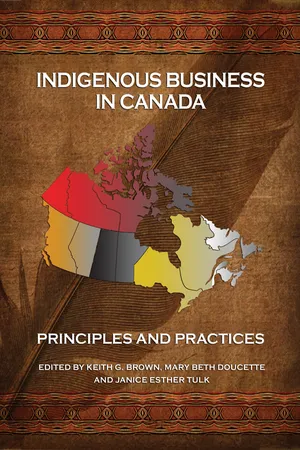
Indigenous Business in Canada
- 312 pages
- English
- ePUB (mobile friendly)
- Available on iOS & Android
Indigenous Business in Canada
About this book
Students who study business in university are not likely to hear about or discuss examples of indigenous business successes from across the country. Rarely would one see references to indigenous communities, let alone examples of them growing multi-million dollar businesses and partnering to lead innovative economic development projects that positively impact the national economy. Resources are scarce and inadequate, an oversight that is to our detriment.Somewhere between a textbook and a book of collected essays, this collection is an effort to build on and share the research of indigenous practitioners and scholars working in their respective fields. Where possible we share not only concepts, but also the voices of Aboriginal leaders, officials, Elders, and other members of Aboriginal communities. Indigenous Business in Canada addresses contemporary concerns and issues in the doing of Aboriginal business in Canada, reveals some of the challenges and diverse approaches to business in indigenous contexts from coast to coast to coast, and demonstrates the direct impact that history and policy, past and present, have on business and business education.
Frequently asked questions
- Essential is ideal for learners and professionals who enjoy exploring a wide range of subjects. Access the Essential Library with 800,000+ trusted titles and best-sellers across business, personal growth, and the humanities. Includes unlimited reading time and Standard Read Aloud voice.
- Complete: Perfect for advanced learners and researchers needing full, unrestricted access. Unlock 1.4M+ books across hundreds of subjects, including academic and specialized titles. The Complete Plan also includes advanced features like Premium Read Aloud and Research Assistant.
Please note we cannot support devices running on iOS 13 and Android 7 or earlier. Learn more about using the app.
Information
Table of contents
- Cover
- Title Page
- Copyright
- Contents
- Note from the Editors
- Foreword
- Introduction
- Chapter 1
- PART ONE
- Chapter 2
- Chapter 3
- Chapter 4
- Chapter 5
- PART TWO
- Chapter 6
- Chapter 7
- Chapter 8
- Chapter 9
- PART THREE
- Chapter 10
- Chapter 11
- Chapter 12
- PART FOUR
- Chapter 13
- Chapter 14
- Timeline of Exploration, Settlement, and Development
- Notes on Contributors
- Index